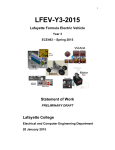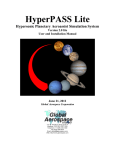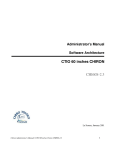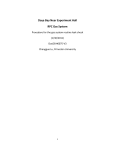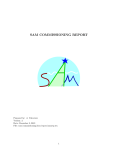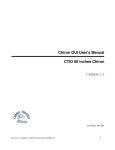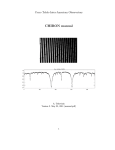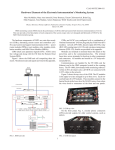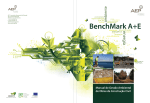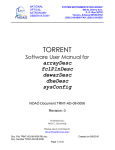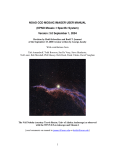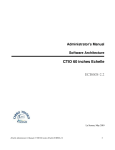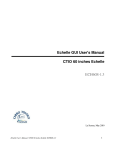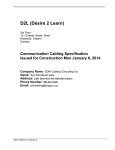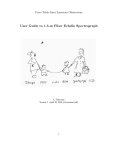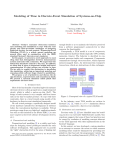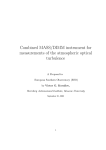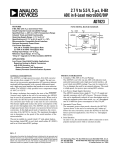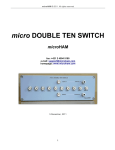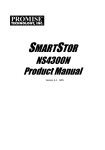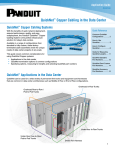Download Orange controller for fiber echelle: final report
Transcript
Orange controller for fiber echelle: final report A. Tokovinin, R. Schmidt, M. Bonati Version 1.1. January 9, 2010 file: prj/bme/doc/orange report.tex This document presents the final report on the ACTR project #454. The goal of the project was to upgrade the controller and data-taking software of FECH from Arcon+IRAF to Monsoon+Arcview by the end of CY 2009. Figure 1: Installation of the new controller on December 30, 2009: R. Alravez, O. Saá, R. Schmidt, M. Hernandez, M. Bonati, D. Rojas. 1 1 Sequence of events and actions (Feb. 2009 to Jan. 2010) February 6: Proposal to ACTR to upgrade the controller and computer of fiber echelle. Remaining funds from the “Design study” sub-award would serve for purchasing the hardware. March 17: The ACTR decides to do the controller upgrade and to use Monsoon Orange, rather than Leach. See [1] for the definition of the ACTR project #454 presented by A. Tokovinin (AT). May 1: R. Schmidt (RS) sends technical information to M. Hunten (MH), the controller fabrication begins. June 22-26: A decision to attach the controller to the CCD is taken, suggested by MH and approved by RS and AT. August 9: Tim Abbott develops detailed project schedule. August 17: Monsoon Orange is delivered to La Serena. The delay is 1 month w.r.t. original plan. August-October: A. Cisternas designs a mechanical system to suspend the controller below the dewar. Its fabrication takes some time and is finished first week of October. November 9-11: AT strongly objects to suspending controller from the CCD dewar. RS agrees that having short cables is easier and safer, but may increase noise. It is decided to make cables. Meanwhile, the data-taking software developed by M. Bonati (MB) is nearly ready, connection to the TCS is tested. See [2] for the project status at this stage. November 9-17: Discussion of the forthcoming 1-month echelle shutdown. SMARTS has not been informed timely (in March), the schedules are made, and the shutdown impacts some programs. It is finally decided to go ahead with the shutdown. December 1: Echelle shutdown starts. The dewar is removed and sent to La Serena (cold, in carry-all). During the following two days, the CCD was tested by RS and MB with Arcon, to get reference performance. Then the temperature control was tuned by MB on Dec. 4. December: MB and Xavier Rojas (XR) install the ADAM module in the electronic box which controls the comparison lamps and prism motion and check the functionality. New Ethernet line is installed at the telescope to connect ADAM with external world. December 10: First images with the new controller are acquired. They are still noisy. December 18: Brain-storm meeting between RS,MB,EM,MW,RA,PM to solve the noise problem. December 21: The noise is brought down to 7.5ADU (6.3el). This is about 10 µV, or ∼ 2 times better than noise at the KPNO Orange system. The noise reduction was achieved by removing the relay in the power supply (the analogue voltages are proviosnally switched manually). December 29: The relay (this time driven by 110VAC) is installed again by RA in Power Supply box, the noise is not affected. AT takes test images with the new system. December 30: The dewar and controller are installed at echelle and tested. The molecular sieve in the dewar was replaced. January 2: MB installs the RS-232 cable to the Lakeshore temp. controller and makes a list of SW modifications after talking to the observer, D. Fischer (DF). AT adjusts the dewar position angle and focus by taking comparison spectra. January 4: First (technical) echelle night with the new controller and data-taking software. Observers J. Velasquez (SMARTS), DF, J. Brewer, AT. MB works night and day to adapt the software and to fix remaining bugs. January 5-6: First regular observing nights with the echelle. 2 Coude room systran fiber Linux PC Ethernet Dewar RS−232 Rack behind control room shutter Monsoon Orange Telescope ADAM +5V Power−supply Lakeshore box Figure 2: Elements of the new controller system and their connections. 2 System description The new controller consists of several inter-connected modules (Fig. 2). CCD: SITE SI424A 2K x 2K CCD with 24 µm pixels. This CCD has 4 output amplifiers. The two “upper” were used by Arcon. Dewar: One of CTIO’s golden MK II dewars. It uses LN2 for cooling and has a hold time of about 14 hours. Two 41-pin connectors (with exactly the same pinout as used by Arcon) are used for CCD signals, temperature sensing and to drive the heater. New controller: Orange Monsoon. This uses a 4 slot Monsoon in a hermetic housing. The controller has three boards (Master Controller board, Clock board and an 8-channel Acquisition board). It also uses two transition boards: one for the Clock and one for the Acquisition board. The power supply is in a separate (gray) box. Orange Monsoon has two additional connectors: one for the shutter control output and another for the data fibers. See Fig. 3 for a concept drawing (there are a few differences with respect to our unit). The controller is connected to the dewar with two cables of 25-cm length (plus 60-mm connectors on both ends). The cost of the controller and other components is given in Table 3 in [1]. Power supply box: it contains several Acopian linear power supplies that generate 5V digital, ±5V analog, ±15V analog, and 32V. This unit had to be modified (K1 was replaced by a relay) to keep the noise down. See Fig. 4 for a view of this box. 3 Figure 3: Monsoon Orange conceptual drawing. Box size 435x390x108 mm, mass 9.9 kg. Temperature controller: Lakeshore model 325 temperature controller is used for the CCD temperature stabilization. The signals for temperature sensing and heater control go from the 41-pin hermetic connectors through the Orange Monsoon to a couple of Lemo connectors. Additional power supply +5V is also needed to drive the heater. Comparison-lamp control is now automated by installing the ADAM 6050 module in the electronics box at the telescope. The module is connected to the PC via Ethernet (Ethernet cable to the telescope was added). Linux PC computer is installed in the back of the console room. It is connected to other elements by a dedicated optical fiber, RS-232 serial line and Ethernet (Fig. 2). The observer connects to this PC via VNC from any terminal in the console room. 3 3.1 Performance of the detector with the new controller Waveforms and modes The waveforms of Monsoon Orange are designed to approximate those of Arcon used with the same CCD, at faster readout speed. Three files (SI424A.ucd, SI424A normal.mod and SI424A fast.mod) are used two generate the waveforms and the bias voltages for the CCD. The original idea is to keep reading the CCD through the two upper amplifiers. Presently there are two readout modes with different gains, speeds and noise. It is possible to select a region-of-interest (ROI) or bin the signal in the line and/or column directions. An attempt to increase the pixel time further for reducing the readout noise and approaching the performance of Arcon in this respect was not successful. The gain and offset with a longer pixel time could be adjusted only by hardware changes, and there was not enough time to implement and test 4 Figure 4: Power supply box. Table 1: Readout modes and parameters Parameter Pixel time, µs Dwell time, µs Readout time, s Gain e-/ADU RON, ADU RON, e- Fast mode OUT1 OUT2 5.2 0.8 18 3.3 3.0 2.8 3.3 9.2 9.9 Normal mode OUT1 OUT2 8.9 2.65 27 0.91 0.81 8.0 8.2 7.3 6.6 those changes. 3.2 Noise and readout speed Table 1 lists the pixel time and the full-chip readout time (without binning) in the two available modes, for each of the two amplifiers (OUT1 is upper-left, OUT2 is upper-right). The readout noise was measured in the overscan region by RS. The gains were measured independently by MB and RS, their results differ by few percent. Note that the higher gain of the upper-left amplifier is the CCD feature which was known with Arcon and is independent of the controller. 5 Figure 5: Power spectrum of the CCD line signal in the fast (left) and normal (right) readout modes obtained on Dec 29, 2009 in the lab. Figure 6: Power spectrum of the CCD line signal in the fast (left) and normal (right) readout modes obtained on Dec 30, 2009 at the telescope. 3.3 Pick-up noise The presence of periodic noise was checked by looking at the power spectrum of the signal along the CCD lines. The IDL program noise1.pro reads the bias image, removes few strongly outlying pixels. Average line signal is subtracted from each CCD line, the result is Fourier-transformed, and the average power spectrum of all lines is accumulated. The spectra show an almost uniform component (white noise) and several lines (Figs. 5,6). The overall variance (RON) is dominated by the white noise, the lines give only a small contribution (e.g. about 1 ADU in the normal mode). The frequencies of the two strongest lines, 28.8 kHz and 63.7 kHz, are the same in the laboratory and on the telescope. This means that these signal components are produced by the system itself, possibly in the power supplies. In the normal mode, the Nyquist frequency is 56.2 kHz, therefore the 6 Figure 7: Illustration of the CTE evaluation. line at 63.7 kHz is aliased to 48.7 kHz. The frequency of these periodic noise components does not depend on the readout speed. 3.4 Charge transfer efficiency Figure 7 shows a plot of the single cosmic-ray event. No trace of the signal in adjacent pixels is seen, so the CTE is excellent. 4 Data-taking software and documentation The software for taking images and controlling the comparison lamps is written by MB. It is a substantially modified version of the SOI ArcView software. The GUI is written in LabView (Fig. 8). The software and instrument control are extensively documented by MB in the following: • ECH60S-1.X. GUI User Manual. • ECH60S-2.X: Administrator’s Manual / Software architecture. General system architecture and maintenance: software tree, configuration files, etc. • ECH60S-3.X: Scripting reference. Reference for scripting: commands available, responses, examples, etc • ECH60HF-4.X: CCD temperature control. Temperature controller tuning. 7 Figure 8: Screen-shot of the first GUI version. 8 Figure 9: Left: design of the Monsoon Orange mechanical coupling to the dewar (implemented, but not used). Right: provisional installation of the Monsoon Orange on Dec 30, 2009. • ECH60HF-5.X: comparison lamps automation. Comparison lamps schematic / hardware changes. • ECH60HF-6.X: Panview configuration. Hardware files / drivers descriptions. 5 Mechanical details The Arcon controller was rigidly attached to the dewar. Originally, it was planned to do the same with Monsoon Orange (Fig. 9, left). However, the Orange is heavier (9.9 kg compared to 6 kg for Arcon) and bigger. It is a source of mechanical and thermal perturbations which are disruptive for highprecision radial-velocity work done with the echelle. Connecting the controller with cables removes the mechanical coupling. It is also easier to implement and less risky for the dewar connector pins. Figure 9 (right) shows a picture of the provisional controller installation where it is strapped to a wooden box of suitable height. In the definitive installation, the controller will be in the “vertical” position (as planned initially), but displaced below and sideways w.r.t. the dewar connectors. The controller box will be rigidly attached to the white tubular frame holding the spectrograph and will be electrically isolated from it. 6 Conclusion: lessons learned The controller upgrade has significantly improved the echelle operation. Now time and labor losses for changes between echelle and RCspec are eliminated, calibrations can be taken during daytime without dependence on the RCspec. Data storage and transfer are improved. More importantly, though, the readout time is now much shorter (27s, compared to 105s with Arcon in normal mode), effectively 9 increasing the number of photons collected by the telescope. The bigger readout noise is the only negative (and foreseen) consequence of the upgrade. Monsoon Orange is not a “plug-and-play” device. The controller was delivered with sufficient technical documentation. The results of Monsoon tests were supplied as well, but since it was not tested with an actual CCD, some noise problems were not detected. In future controller upgrades, it will be important to perform and report tests of the hardware prior to its delivery. A certain number of problems was found and solved as part of the normal learning/debugging process with a new system. One pending issue is reaching reliable communication through Systran board and leaving the system work in this definitive configuration. This also implies changing the PC computer. The new controllers should provide the same functionality as the existing Arcons (see Torrrent requirements in [3]). This is not the case for Monsoon Orange. We were not able to reproduce the slow Arcon-like readout mode (and to reduce the RON) because with the long pixel time the gain became unacceptably small and the large signal offset was beyond the compensation range. Currently, the “normal” mode is much faster than the Arcon’s slow mode. RS repeatedly pointed out that this system has no spares. Some spares may become available only after the prototype DECam system is de-commissioned, but there are many caveats (e.g., the boards from DECam system first need to go through a rather time consuming modification, calibration and test procedure before they are ready as spares). Any failure will disrupt echelle observations and will to be addressed by bringing the dewar to La Serena. The hope is that the controller will not fail during one year of planned operation, until the new echelle spectrometer is commissioned. References [1] Orange controller for fiber echelle. March 30, 2009 (DocDB 192-v2) [2] ACTR project #454: Orange Monsoon for 1.5-m. Nov. 30, 2009 (DocDB 235-v1). [3] Torrent development status. M.Hunten et al. March 18, 2009 (DocDB 198-v1) 10










